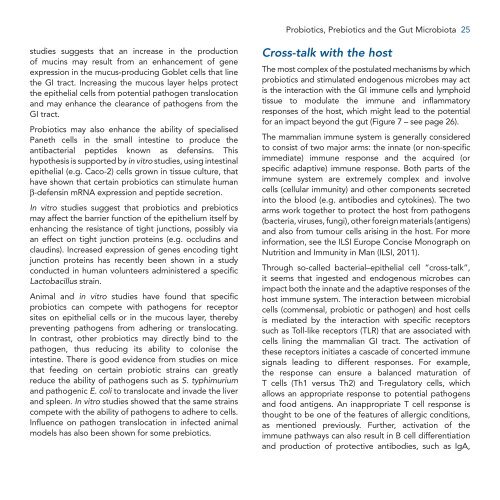probiotics, prebiotics and the gut microbiota - International Life ...
probiotics, prebiotics and the gut microbiota - International Life ...
probiotics, prebiotics and the gut microbiota - International Life ...
Create successful ePaper yourself
Turn your PDF publications into a flip-book with our unique Google optimized e-Paper software.
Probiotics, Prebiotics <strong>and</strong> <strong>the</strong> Gut Microbiota 25studies suggests that an increase in <strong>the</strong> productionof mucins may result from an enhancement of geneexpression in <strong>the</strong> mucus-producing Goblet cells that line<strong>the</strong> GI tract. Increasing <strong>the</strong> mucous layer helps protect<strong>the</strong> epi<strong>the</strong>lial cells from potential pathogen translocation<strong>and</strong> may enhance <strong>the</strong> clearance of pathogens from <strong>the</strong>GI tract.Probiotics may also enhance <strong>the</strong> ability of specialisedPaneth cells in <strong>the</strong> small intestine to produce <strong>the</strong>antibacterial peptides known as defensins. Thishypo<strong>the</strong>sis is supported by in vitro studies, using intestinalepi<strong>the</strong>lial (e.g. Caco-2) cells grown in tissue culture, thathave shown that certain <strong>probiotics</strong> can stimulate humanβ-defensin mRNA expression <strong>and</strong> peptide secretion.In vitro studies suggest that <strong>probiotics</strong> <strong>and</strong> <strong>prebiotics</strong>may affect <strong>the</strong> barrier function of <strong>the</strong> epi<strong>the</strong>lium itself byenhancing <strong>the</strong> resistance of tight junctions, possibly viaan effect on tight junction proteins (e.g. occludins <strong>and</strong>claudins). Increased expression of genes encoding tightjunction proteins has recently been shown in a studyconducted in human volunteers administered a specificLactobacillus strain.Animal <strong>and</strong> in vitro studies have found that specific<strong>probiotics</strong> can compete with pathogens for receptorsites on epi<strong>the</strong>lial cells or in <strong>the</strong> mucous layer, <strong>the</strong>rebypreventing pathogens from adhering or translocating.In contrast, o<strong>the</strong>r <strong>probiotics</strong> may directly bind to <strong>the</strong>pathogen, thus reducing its ability to colonise <strong>the</strong>intestine. There is good evidence from studies on micethat feeding on certain probiotic strains can greatlyreduce <strong>the</strong> ability of pathogens such as S. typhimurium<strong>and</strong> pathogenic E. coli to translocate <strong>and</strong> invade <strong>the</strong> liver<strong>and</strong> spleen. In vitro studies showed that <strong>the</strong> same strainscompete with <strong>the</strong> ability of pathogens to adhere to cells.Influence on pathogen translocation in infected animalmodels has also been shown for some <strong>prebiotics</strong>.Cross-talk with <strong>the</strong> hostThe most complex of <strong>the</strong> postulated mechanisms by which<strong>probiotics</strong> <strong>and</strong> stimulated endogenous microbes may actis <strong>the</strong> interaction with <strong>the</strong> GI immune cells <strong>and</strong> lymphoidtissue to modulate <strong>the</strong> immune <strong>and</strong> inflammatoryresponses of <strong>the</strong> host, which might lead to <strong>the</strong> potentialfor an impact beyond <strong>the</strong> <strong>gut</strong> (Figure 7 – see page 26).The mammalian immune system is generally consideredto consist of two major arms: <strong>the</strong> innate (or non-specificimmediate) immune response <strong>and</strong> <strong>the</strong> acquired (orspecific adaptive) immune response. Both parts of <strong>the</strong>immune system are extremely complex <strong>and</strong> involvecells (cellular immunity) <strong>and</strong> o<strong>the</strong>r components secretedinto <strong>the</strong> blood (e.g. antibodies <strong>and</strong> cytokines). The twoarms work toge<strong>the</strong>r to protect <strong>the</strong> host from pathogens(bacteria, viruses, fungi), o<strong>the</strong>r foreign materials (antigens)<strong>and</strong> also from tumour cells arising in <strong>the</strong> host. For moreinformation, see <strong>the</strong> ILSI Europe Concise Monograph onNutrition <strong>and</strong> Immunity in Man (ILSI, 2011).Through so-called bacterial–epi<strong>the</strong>lial cell “cross-talk”,it seems that ingested <strong>and</strong> endogenous microbes canimpact both <strong>the</strong> innate <strong>and</strong> <strong>the</strong> adaptive responses of <strong>the</strong>host immune system. The interaction between microbialcells (commensal, probiotic or pathogen) <strong>and</strong> host cellsis mediated by <strong>the</strong> interaction with specific receptorssuch as Toll-like receptors (TLR) that are associated withcells lining <strong>the</strong> mammalian GI tract. The activation of<strong>the</strong>se receptors initiates a cascade of concerted immunesignals leading to different responses. For example,<strong>the</strong> response can ensure a balanced maturation ofT cells (Th1 versus Th2) <strong>and</strong> T-regulatory cells, whichallows an appropriate response to potential pathogens<strong>and</strong> food antigens. An inappropriate T cell response isthought to be one of <strong>the</strong> features of allergic conditions,as mentioned previously. Fur<strong>the</strong>r, activation of <strong>the</strong>immune pathways can also result in B cell differentiation<strong>and</strong> production of protective antibodies, such as IgA,
















